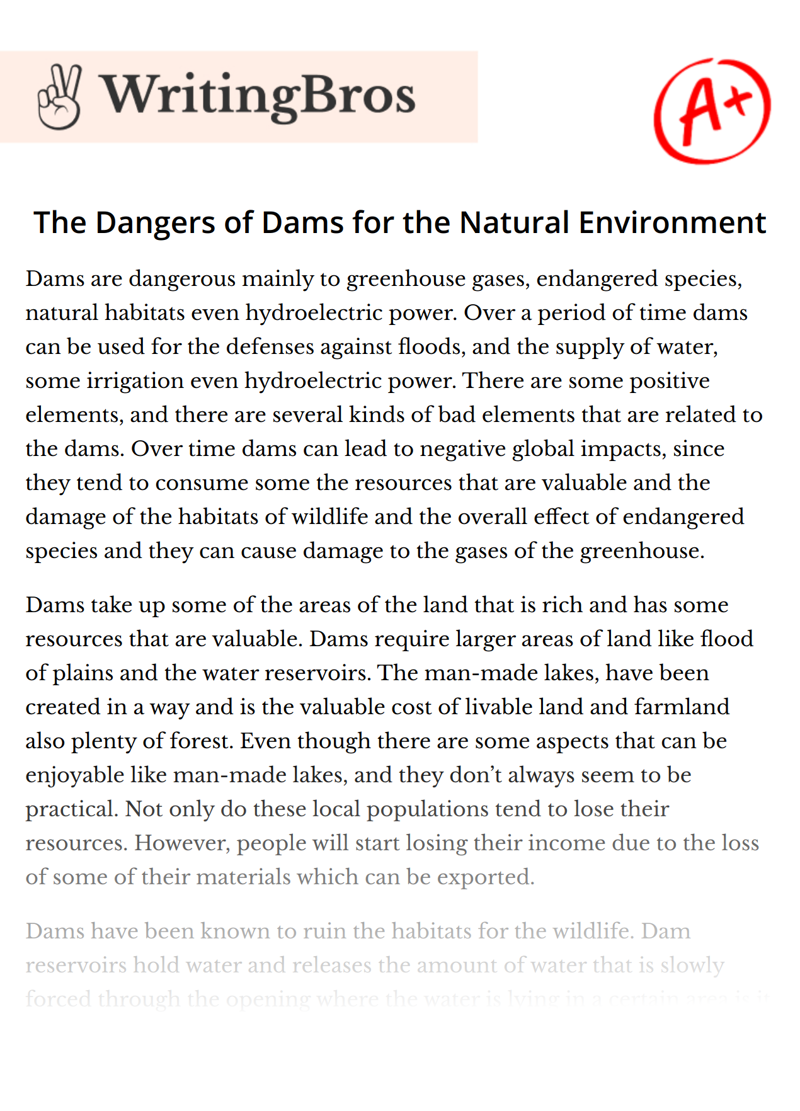The Dangers of Dams for the Natural Environment

Dams are dangerous mainly to greenhouse gases, endangered species, natural habitats even hydroelectric power. Over a period of time dams can be used for the defenses against floods, and the supply of water, some irrigation even hydroelectric power. There are some positive elements, and there are several kinds of bad elements that are related to the dams. Over time dams can lead to negative global impacts, since they tend to consume some the resources that are valuable and the damage of the habitats of wildlife and the overall effect of endangered species and they can cause damage to the gases of the greenhouse.
Dams take up some of the areas of the land that is rich and has some resources that are valuable. Dams require larger areas of land like flood of plains and the water reservoirs. The man-made lakes, have been created in a way and is the valuable cost of livable land and farmland also plenty of forest. Even though there are some aspects that can be enjoyable like man-made lakes, and they don’t always seem to be practical. Not only do these local populations tend to lose their resources. However, people will start losing their income due to the loss of some of their materials which can be exported.
Dams have been known to ruin the habitats for the wildlife. Dam reservoirs hold water and releases the amount of water that is slowly forced through the opening where the water is lying in a certain area is it starts to heat the surface. Over time the water declines which are due to a the lack of movement and starts to become lower in the supply of oxygen. It is really important that plants need to have oxygen in order for the survival die off.
Endangered species are threatened by the overall system of the dam. The natural systems often lead to significantly affect the dams that are being destroyed or they are being negatively modified. Weeds have been known to flourish in areas that are low oxygenated because they begin to break down the overall system of water and it can be absorbed by the remaining resources. The amazon “River Balbina” reservoirs and “in the introduction of a herd of grazing manatees have failed to staunch the spread of weeds” (Pearce, 2000). These kinds of weeds start to rot leading to have a negative effect on greenhouse gases.
Greenhouse gases have been known to be dangerously effect on the atmosphere throughout climate change. In regards to the “reservoirs that are created by one-fifth of all man-made methane in the atmosphere”. When it comes to climate change drastically effects the overall life on earth. By focusing on something like polar ice caps as an example when they are melting because of the temperature rising. The coastal cities that start to lose some land when the water levels rise in the ocean. When it comes to tidal waves that start to form and shift in the atmosphere. These kinds of occurrences come together to create the greenhouse effect on the dams “there is no justification for claiming that hydroelectricity does not contribute significantly when it comes to global warming” (Weiser 2016). The data that is being collected and, the overall creation of dams when it seems to be deadly. We are learning the dangers of hydroelectric dams. There are alternatives when it comes to wind and solar power which are both green with energy sources that later on tend to replace the need for dams.
By focusing on the audience who believe that dams are safe. Well the true is that dams have been known to be structures in which it obstructs the flow of water in streams, rivers even other bodies of water which is created to the confinement of water that is upstream or behind each of the structures. Over time the dams obstruct the natural water flow and there are significant effects on rivers and streams ecosystems. Even though dams provide some benefits such as hydroelectric power and flood control, however, there are also a number of negative impacts are environmental. Dams have been designed for several purposes that include irrigation, flood control, hydroelectric power, generation conversation, recreation even navigation. Well dams are known to be dangerous to a lot of the overall purpose and the impact that they have when it comes to things like greenhouse gases, natural habitats even endangered species. The degree of danger of the earth’s dam reservoir that operated during the flood season. According to the “World Commission on Dams” scientist, environmentalist and engineers have support what is known as the world bank which is one of the world’s biggest funders of the large dams. The hydroelectric reservoirs can release methane and carbon dioxide.
The dams can be extremely dangerous and has a really big impact on our natural environment. The dangers of dams can have an impact are the things like endangered species, natural habitats even greenhouse gases. Another thing is that it can also impact the change in the climate during that period of time. We don’t really spend a lot of time thinking about the environment can be impacted when a dam breaks.
Cite this Essay
To export a reference to this article please select a referencing style below

